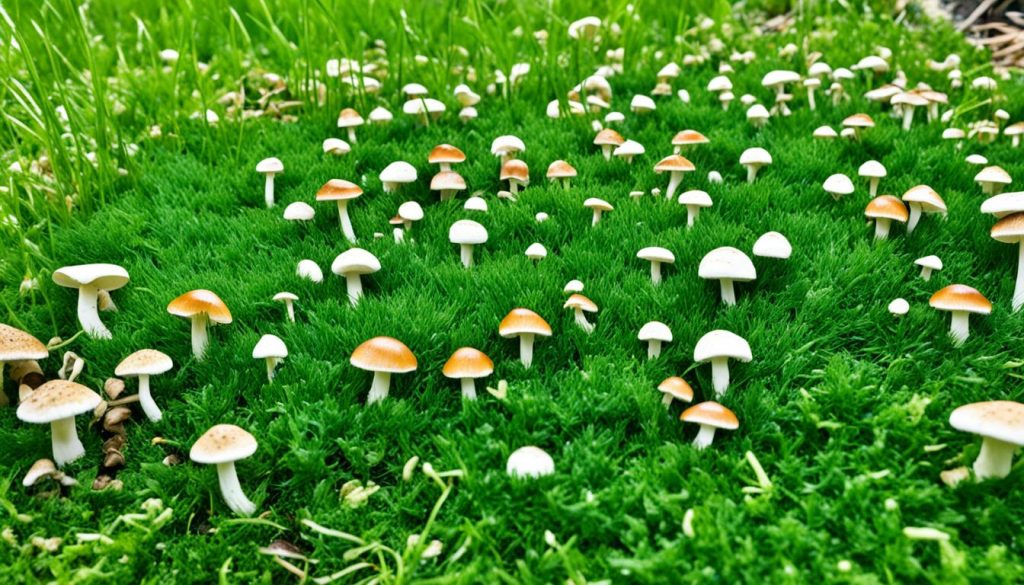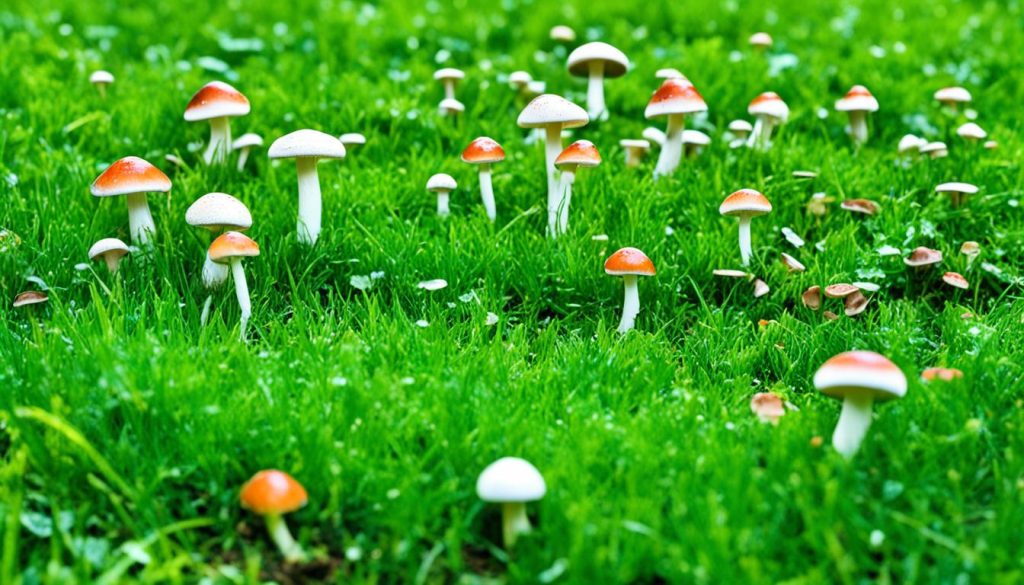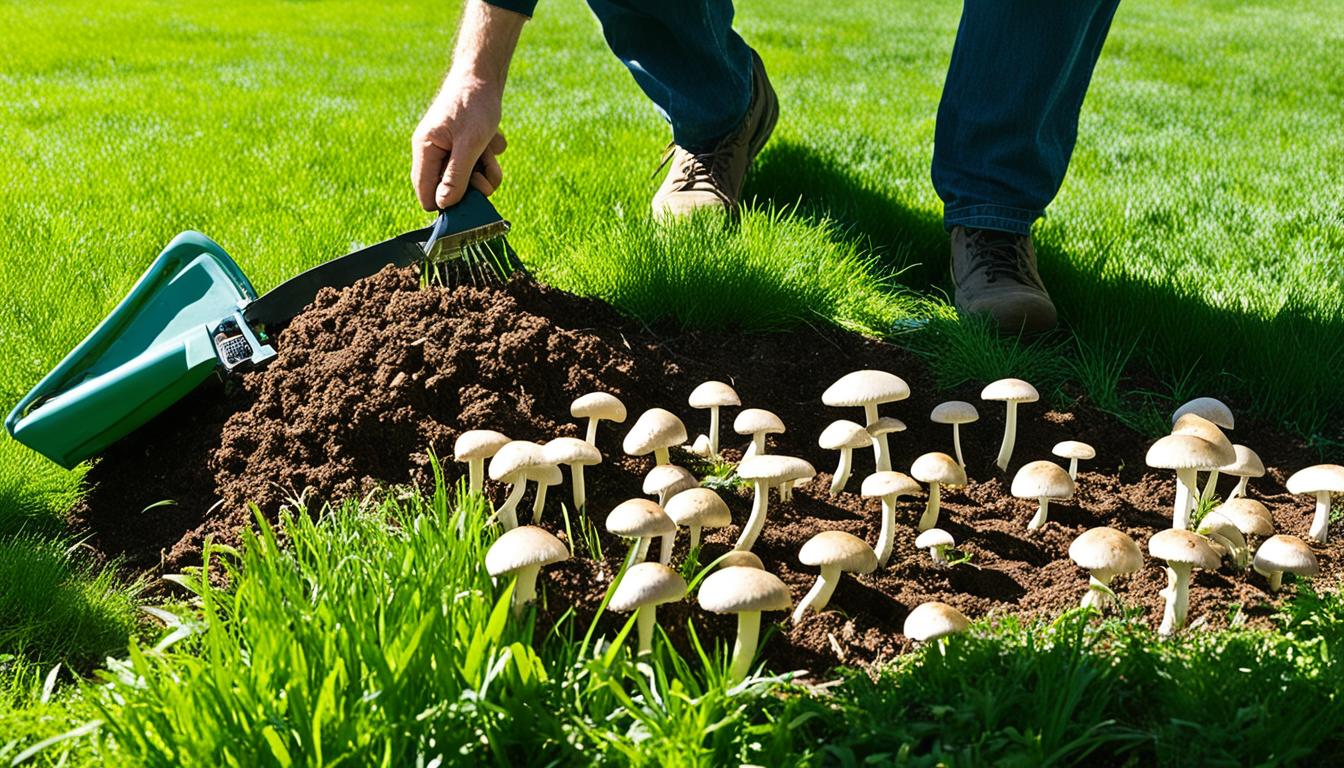Are you tired of mushrooms sprouting up all over your beautifully manicured lawn? Not only are they unsightly, but they can also be potentially harmful to children and pets. But why do mushrooms keep appearing, and more importantly, how can you prevent them?
In this article, we will explore the reasons behind the growth of mushrooms in your yard and provide practical tips on how to remove them and keep them from coming back. Whether you’re dealing with a few small patches or a full-fledged mushroom invasion, we’ve got you covered with effective strategies for lawn mushroom prevention.
Before we dive into the solutions, it’s important to understand the root causes of mushrooms in your yard. By identifying these factors, you’ll gain valuable insights into how to tackle the problem effectively.
Key Takeaways:
- Understanding the reasons behind mushroom growth in lawns helps you implement targeted prevention strategies.
- Mushrooms require warmth, moisture, and organic matter to thrive, which can be influenced by factors like overwatering, poor soil drainage, and decaying organic material.
- While some mushrooms can be harmful, others contribute to the overall health of your lawn.
- Accurate identification of mushroom species is crucial in assessing their potential risks and benefits.
- Implementing proper lawn care practices and making adjustments to watering and soil conditions can prevent mushrooms from returning.
Why Mushrooms Grow in Your Yard
Mushrooms can often be found sprouting in yards, adding an enchanting touch to the landscape. However, their presence can also raise questions about why they grow in the first place. Understanding the reasons behind mushroom growth in your yard can help you address the issue effectively.
Several factors contribute to the proliferation of mushrooms in yards. These fungi require specific conditions to thrive, namely warmth, moisture, and organic matter. Here are some common causes of mushrooms popping up in your yard:
- Overwatering: Excessive watering can create a damp environment that mushrooms find favorable for growth.
- Heavy rains: After periods of heavy rainfall, the excess moisture in the soil provides an ideal habitat for mushrooms.
- Poor soil drainage: If your yard has inadequate drainage, water may accumulate, creating the moist conditions mushrooms need.
- Extended shade: Mushrooms thrive in shaded areas where sunlight is limited, such as under trees or in areas with dense foliage.
- Decaying organic matter: Dead or decaying organic matter like tree stumps, thatch, fallen leaves, grass clippings, or animal waste can serve as a food source for mushrooms.
By addressing these underlying causes, you can effectively prevent and manage mushroom growth in your yard. It’s important to remember that mushrooms are simply the visible fruiting bodies of fungi and are typically harmless. However, to ensure the safety of children and pets, it’s essential to accurately identify mushrooms and take appropriate action if they are potentially poisonous.
| Common Causes of Mushroom Growth | Effects on Yard |
|---|---|
| Overwatering | Creates a damp environment suitable for mushroom growth |
| Heavy rains | Excess moisture promotes mushroom growth |
| Poor soil drainage | Water accumulation creates favorable conditions for mushrooms |
| Extended shade | Shaded areas restrict sunlight, allowing mushrooms to thrive |
| Decaying organic matter | Dead or decaying organic matter serves as a food source for mushrooms |
Are Mushrooms Bad for Your Lawn?
While some mushrooms are harmful and should be promptly removed to protect children and pets, others can actually have positive effects on the overall health of your lawn.
However, it is important to note that certain types of fungi can pose risks to your grass. In particular, certain species of mushrooms can cause lawn diseases such as brown patch or large patch. These diseases can result in damage to your grass, creating bare spots in your lawn that can be unsightly and difficult to repair.
To ensure the well-being of your lawn, it is essential to understand the potential effects of mushrooms and take appropriate measures to manage them.

The Effects of Mushrooms on Grass
While mushrooms may seem harmless, they can influence the health and appearance of your grass in several ways:
- Mushrooms can compete with grass for nutrients, potentially depriving your lawn of essential resources for growth and maintenance.
- The presence of mushrooms can create shade and prevent sunlight from reaching your grass, hindering its ability to photosynthesize and thrive.
- In some cases, certain types of mushrooms can release toxins that are harmful to grass, affecting its growth and overall well-being.
Effects of Mushrooms on Grass
| Effects | Description |
|---|---|
| Competition for nutrients | Mushrooms can compete with grass for essential nutrients, potentially inhibiting its growth. |
| Shading | The presence of mushrooms can create shade, limiting the amount of sunlight that reaches the grass and affecting its ability to photosynthesize. |
| Toxin release | In some cases, certain types of mushrooms can release toxins that are harmful to grass, leading to stunted growth or other negative effects. |
While mushrooms may have some adverse effects, they can also contribute to the overall health of your lawn by breaking down organic matter and depositing nutrients back into the soil. It is essential to strike a balance and manage their growth to ensure a healthy and visually appealing lawn.
How to Identify the Mushrooms in Your Yard
Mushrooms come in various shapes, sizes, and colors, making them fascinating but also potentially challenging to identify. Whether you want to determine the risks they pose or appreciate their benefits, accurate identification is essential. Here are some common lawn mushroom species to look out for:
1. Field Mushrooms (Agaricus campestris)
Field mushrooms are a popular species found in lawns and grassy areas. They have whitish caps with a slight dome shape and may have brown scales or spots. The gills underneath the cap are initially pink and later turn dark brown or black. These mushrooms have a delicate aroma and are often found in fairy rings.
2. Shaggy Mane Mushrooms (Coprinus comatus)
Shaggy mane mushrooms are recognizable by their unique appearance. They have white cylindrical caps covered in shaggy scales that darken as the mushroom matures. The gills start out white but eventually turn black and liquefy, giving this species its nickname “inky cap.” Shaggy mane mushrooms can often be found growing in clusters on lawns and disturbed areas.
3. Death Cap Mushrooms (Amanita phalloides)
While it’s crucial to avoid consuming any wild mushrooms, it’s even more imperative to stay away from death cap mushrooms. They are extremely poisonous and can be lethal if ingested. Death cap mushrooms have a pale to olive-green cap, white gills, and a bulb-shaped base. They typically grow near oak, beech, or chestnut trees.
When attempting to identify mushrooms, it’s important to remember that visual cues alone may not be enough to determine the species accurately. Therefore, if you’re unsure about the identification or the potential risks associated with a particular mushroom, it is always best to consult an expert or mycologist for assistance.
It’s important to accurately identify the mushrooms in your yard to assess their potential risks and benefits. Here is an image that showcases the visual characteristics of these common lawn mushroom species:
Reasons to Consider Keeping Mushrooms in Your Yard
Despite their potential downsides, mushrooms can play a beneficial role in your yard by indicating a healthy environment and contributing to the overall health of the soil. Here are some key reasons to consider keeping mushrooms in your yard:
- Breaking down organic matter: Mushrooms are natural decomposers and break down dead organic matter, such as fallen leaves, grass clippings, and tree stumps. This decomposition process helps to recycle nutrients back into the soil, creating a fertile environment for plant growth.
- Adding nutrients to the soil: As mushrooms break down organic matter, they release nutrients into the surrounding soil. These nutrients, including nitrogen, phosphorus, and potassium, are essential for plant health and can promote lush, vibrant lawn growth.
- Promoting soil structure: The mycelium, which is the underground part of the mushroom, forms a network of fine threads that extend throughout the soil. This network helps to improve soil structure by creating channels for water and air movement, enhancing drainage, and preventing compaction.
By allowing mushrooms to thrive in your yard, you are fostering a more balanced and healthy ecosystem. However, it’s important to note that not all mushrooms are beneficial. Some species can be poisonous or harmful to children and pets, so it’s crucial to correctly identify them before deciding whether to keep them or remove them.
Mushrooms as a Sign of Healthy Soil
Mushrooms growing in your yard can be viewed as a positive sign, indicating that your soil is rich in organic matter and has a good balance of nutrients. Healthy soil is the foundation for a thriving lawn as it provides the essential elements necessary for plant growth.
The presence of mushrooms suggests that the soil is teeming with beneficial microorganisms, such as bacteria and fungi, that contribute to the natural breakdown of organic matter. These microorganisms help to create a nutrient-rich environment that supports robust root development and enhances the overall resilience and health of your lawn.
To better understand the benefits of mushrooms and their relationship to healthy soil, refer to the table below:
| Benefits of Mushrooms in Your Yard | Benefits of Healthy Soil |
|---|---|
| Break down organic matter, recycling nutrients | Supports strong root development |
| Add nutrients to the soil | Enhances nutrient availability |
| Improve soil structure and drainage | Prevents soil erosion |
| Indicate a balanced ecosystem | Promotes diverse microbial activity |

As you can see, mushrooms not only contribute to the aesthetics of your yard but also provide various benefits to the underlying soil. Embracing mushrooms as a natural part of your yard’s ecosystem can result in a healthier and more vibrant lawn.
How to Get Rid of Mushrooms in Your Yard
While removing mushrooms entirely is not necessary, targeted removal can help maintain a visually appealing yard. Here are some effective lawn mushroom removal techniques:
- Dig out the mushroom clusters: Use a small garden shovel or trowel to carefully dig out the mushrooms and their underground mycelium. Be sure to remove the entire cluster to prevent regrowth.
- Mow over the mushrooms: For larger areas with scattered mushrooms, mowing over them can help break them up and prevent spore dispersal.
- DIY fungicide: Create a natural fungicide by mixing equal parts vinegar and water, or dish soap and water. Spray the solution directly on the mushrooms to inhibit their growth.
Remember, patience can also be effective in removing mushrooms. They will naturally disappear with changes in weather conditions.
How to Prevent Mushrooms From Coming Back
To prevent mushrooms from returning, you can adjust your lawn care practices. By incorporating these preventative measures, you can effectively minimize the chances of mushroom regrowth and maintain a healthy, fungus-free yard.
1. Watering Smarter
Give your lawn adequate time to dry between watering sessions. Overwatering creates a damp environment, which is ideal for mushroom growth. By watering smarter and allowing the soil to dry out, you can discourage mushrooms from thriving.
2. Improving Soil Drainage
Aerate your lawn to improve soil drainage. Compacted soil retains moisture, promoting mushroom growth. By regularly aerating your lawn, you allow water to penetrate deeper into the soil, preventing excessive moisture buildup.
3. Reducing Shady Spots
Mushrooms thrive in dark, shaded areas. Trim back overhanging trees or shrubs to reduce shade and increase sunlight exposure in your yard. This will create an unfavorable environment for mushrooms to grow.
4. Conducting a Thorough Yard Cleanup
Regularly clean up your yard to remove potential mushroom-inducing debris, such as fallen leaves, grass clippings, or decaying organic matter. By keeping your yard clean and free of organic material, you eliminate a food source for mushrooms.
5. Using Natural Fungicides
Try using natural fungicides like vinegar or dish soap. These substances can be effective at preventing mushroom regrowth. Mix equal parts vinegar and water, or a tablespoon of dish soap with a gallon of water, and spray the solution in mushroom-prone areas.
Tips for Mushroom Control in Lawns
When it comes to eliminating mushrooms from your lawn, there are several effective strategies you can employ. By implementing these lawn mushroom control tips, you can ensure a healthy, mushroom-free yard.
1. Apply High Nitrogen Fertilizer
One way to control mushrooms is by strengthening your grass. Applying a high nitrogen fertilizer will help promote healthy grass growth and discourage mushroom development. Ensure you follow the recommended application guidelines for the specific fertilizer you choose.
2. Adjust Soil pH with Baking Soda or Fungicides
Mushrooms thrive in certain soil conditions, so adjusting the pH can create an inhospitable environment for their growth. You can accomplish this by sprinkling baking soda over the affected areas. Alternatively, you can use commercial fungicides designed to modify soil pH. Follow the instructions provided by the manufacturer for safe and effective application.
3. Remove Mushrooms by Hand
If you spot mushrooms in your lawn, it’s essential to remove them promptly. Safely remove mushrooms by hand while wearing gloves to protect your skin. Be sure to dig deep to remove the entire mushroom and its root system. Dispose of the mushrooms in a sealed bag or container to prevent spore spread.
| Mushroom Control Tips: |
|---|
| Apply high nitrogen fertilizer to strengthen grass |
| Adjust soil pH with baking soda or fungicides |
| Remove mushrooms by hand |
4. Lawn Maintenance Practices
Regular lawn maintenance plays a key role in preventing mushrooms from recurring. By following these practices, you can create a less favorable environment for mushroom growth:
- Mow your lawn regularly to keep grass at an appropriate height.
- Remove fallen leaves, thatch, and other organic matter promptly.
- Aerate your lawn to improve soil drainage.
- Minimize shaded areas by pruning trees or shrubs.
- Water your lawn deeply and infrequently to avoid overwatering.
Remember, controlling mushrooms in your lawn may require persistence and repeated efforts. By implementing these tips and maintaining consistent lawn care practices, you can successfully eliminate mushrooms and enjoy a beautiful, healthy lawn.
Lawn Maintenance for Mushroom Prevention
Regular lawn maintenance practices are essential for preventing mushrooms from growing in your yard. By implementing these tips, you can create an environment that discourages mushroom growth and promotes a healthy, beautiful lawn.
Clear Organic Matter
Clearing organic matter, such as grass clippings and leaves, is crucial in preventing mushrooms. These materials provide a food source for fungi and create a favorable environment for their growth.
Dethatching
Dethatching involves removing dead grass and moss from your lawn. This process helps improve airflow, reduce moisture retention, and prevent the accumulation of organic matter that mushrooms thrive on.
Improve Lawn Drainage
Poor soil drainage can contribute to mushroom growth. Ensure that your lawn has proper drainage by addressing any issues with compacted soil, uneven surfaces, or areas prone to pooling water.
Aerate the Soil
Aerating the soil allows for improved water and nutrient absorption, creating a healthier environment for grass and discouraging mushroom growth. Use a mechanical aerator or consider hiring a professional for larger lawns.
Water Sparingly and at Appropriate Times
Overwatering can create excessive moisture levels, which mushrooms thrive in. Water your lawn deeply but infrequently to encourage deep root growth and avoid shallow, moist soil that favors mushroom development. Watering early in the morning allows the grass to dry throughout the day and reduces the overall moisture content in your lawn.
Promote Healthy Grass Growth
Fertilizing your lawn with a high-quality, appropriate nitrogen fertilizer helps promote healthy grass growth, making it less susceptible to mushroom invasion. Ensure you follow the manufacturer’s instructions and apply fertilizer at the recommended intervals.
| Preventive Technique | Benefits |
|---|---|
| Clear organic matter | Discourages mushroom growth by eliminating their food source |
| Dethatching | Removes dead grass and moss, preventing organic matter build-up |
| Improve lawn drainage | Reduces favorable conditions for mushrooms by minimizing excess moisture |
| Aerate the soil | Promotes healthy grass growth and improves the overall soil environment |
| Water sparingly | Controls moisture levels and limits mushroom-friendly conditions |
| Promote healthy grass growth | Strengthens grass and reduces vulnerability to mushroom invasion |
Implementing these lawn maintenance practices will significantly reduce the likelihood of mushrooms appearing in your yard and help you maintain a beautiful and healthy lawn.
Conclusion
Understanding the causes of mushrooms in your yard is the first step towards maintaining a pristine, mushroom-free lawn. By implementing proactive prevention and control strategies, you can create a healthier and more visually appealing outdoor space.
Proper lawn maintenance plays a vital role in preventing mushrooms. Regularly clear organic matter such as grass clippings and leaves, and consider dethatching to remove dead grass and moss. Improving lawn drainage, aerating the soil, watering sparingly and at appropriate times, and fertilizing to promote healthy grass growth are all essential practices.
In addition to maintenance, targeted removal techniques are effective in managing mushrooms. Whether you choose to dig out mushroom clusters, mow over them, or use DIY fungicides made with vinegar or dish soap, removal can help maintain the aesthetic value of your yard.
Lastly, adjusting watering and soil conditions is crucial. Give your lawn adequate time to dry between watering, and improve soil drainage through aeration. Reduce shaded spots in your yard, conduct regular cleanups, and consider using natural fungicides like vinegar or dish soap to prevent mushroom regrowth.





